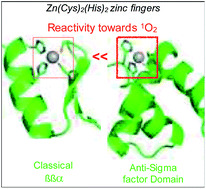Model peptide for anti-sigma factor domain HHCC zinc fingers: high reactivity toward 1O2 leads to domain unfolding†
Abstract
All organisms have to cope with the deleterious effects of reactive oxygen species. Some of them are able to mount a transcriptional response to various oxidative stresses, which involves sensor proteins capable of assessing the redox status of the cell or to detect reactive oxygen species. In this article, we describe the design, synthesis and characterization of Zn·LASD(HHCC), a model for the Zn(Cys)2(His)2 zinc finger site of ChrR, a sensor protein involved in the bacterial defence against singlet oxygen that belongs to the family of zinc-binding anti-sigma factors possessing a characteristic H/C–X24/25–H–X3–C–X2–C motif. The 46-amino acid model peptide LASD(HHCC) was synthetized by solid phase peptide synthesis and its Zn2+-binding properties were investigated using electronic absorption, circular dichroism and NMR. LASD(HHCC) forms a 1 : 1 complex with Zn2+, namely Zn·LASD(HHCC), that adopts a well-defined conformation with the Zn2+ ion capping a 3-helix core that reproduces almost perfectly the fold of the ChrR in the vicinity of its zinc site. H2O2 reacts with Zn·LASD(HHCC) to yield a disulfide with a second order rate constant of 0.030 ± 0.002 M−1 s−1. Zn·LASD(HHCC) reacts rapidly with singlet oxygen to yield sulfinates and sulfonates. A lower limit of the chemical reaction rate constant between Zn·LASD(HHCC) and 1O2 was determined to be 3.9 × 106 M−1 s−1. Therefore, the Zn(Cys)2(His)2 site of Zn·LASD(HHCC) appears to be at least 5 times more reactive toward these two oxidants than that of a classical ββα zinc finger. Consequences for the activation mechanism of ChrR are discussed.



 Please wait while we load your content...
Please wait while we load your content...